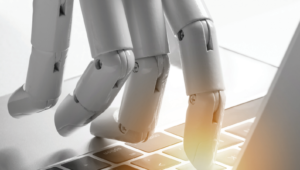Connections

M&E Journal: Maintain Your Creative Focus: How to Simplify Business Processes with Artificial Intelligence
Story Highlights
By Jukka Paajanen, Regional Innovation Lead, Avanade –
It’s the end of the day and you’re looking at the dailies of your production. Something catches your eye, and suddenly, you have an idea. The plot line you shot today needs another scene. But before cameras can start rolling again, there are thousands of forms to complete. Contract updates, requisitions, script addendums, prop orders, content owner approvals; all need sign-off. But much of the required information on these forms is the same, e.g., production name, location and date. Copying and pasting this data is time consuming, monotonous and liable to errors that can throw the whole shoot out of whack. Can you imagine your makeup artist showing up at the wrong place because of a mistake on a form?
From a business angle, the process of adding another scene is not very inspiring. As media companies, your business centers on creative content production and distribution. So, it may seem that automation through artificial intelligence (AI) contradicts the fundamentals of the creative process that is a defining feature of your industry.
In reality, there are several aspects of AI that can manage the mundane and repetitive tasks that are part of most businesses, so you can focus more time on your artistic aspirations.
Business processes in most organizations, including M&E, revolve around forms and workflows, including casting rosters, costumes, prop orders and set building schedules. There are different people in different departments copying the same piece of data on multiple forms. But humans are inefficient, prone to errors and susceptible to distractions and interruptions. AI, on the other hand, is relentless and reliable.
With machine learning, analytics, robotics process automation (RPA) and other intelligence areas, AI promises to be your virtual employee. Most companies typically start with RPA to automate repetitive, and often tedious, internal processes in finance, human resources, demand management, etc.
Wherever you have a group of employees spending a large part of their day processing information that includes copying information from one source to another, RPA comes in handy. It uses the same application interfaces your people use to copy, validate, collate, organize and submit data onto multiple forms. And the best part is that your RPA virtual workers can function around the clock, tirelessly and without human errors.
AI is also intelligent enough to know what is the “happy path,” where processes run smoothly, and all data corresponds to expectations. It can be used to complete specific tasks and determine what requires human attention and then escalate it to the appropriate person. This way humans get to do what they are good at – resolve complex issues, apply emotional intelligence and just be creative – while machines can do what they do best: mechanically move processes along accurately, quickly and efficiently.
 Predict and prepare
Predict and prepare
Even if business processes change over time, AI can adapt. You can move more of the typical exceptions into the happy path, automate them and then later apply machine learning to find patterns that require more attention. For example, if there is a lot of social media attention around a specific film, there may be an influx of preorders that require human involvement.
Or maybe a certain production cycle is prolonged due to temporary requisitions, such as background checks. Machine learning can predict these situations, so you are better prepared to handle fluctuating demands. The constant learning can save you time trying to guess or manually review data to predict outcomes.
This same concept also applies to finance process execution data. For example, if there is a threshold for invoices that require human intervention set at $10,000, AI can use your data to show that there is no significant difference in fraudulent or erroneous invoices between $8,593 and $14,335. By allowing the higher limit of $14,335, you can automatically process another 15 percent of invoices and alleviate the finance department’s workload. By building a predictive model based on the data, you can further refine financial business rules to save both time and money.
Analyze perceptions
The benefits of AI do not just apply to internal operations. There are multiple externally-facing benefits as well. AI can be used to better understand consumer behavior by combining and analyzing data from various sources — such as review sites, websites, social media and schedules of competing events — to predict when and what kind of marketing messages resonate best with your target audience. It can also determine which combination of actors, directors, plots and other attributes will attract your target demographic. For example, there may be a hidden correlation between certain types of math puzzles and Black Panther that could be used for cross promotion.
AI can also tag and classify your back catalog. Current tools for facial recognition, speechto- text, object recognition, etc., can be used to analyze your back catalog of hundreds of TV episodes and automatically tag which actor is in a scene talking about a particular topic.
AI can even contribute to your creative work. With a built-in neural network, it can automate some of the standard or recurrent aspects of film development, such as scenery, digital props and special effects. It can also take the style of one picture and apply it to a second. For example, if you input a recent photo of the Hollywood sign and an artistic masterpiece, such as a Van Gogh painting, AI can apply the style of the masterpiece to make the current photo look like Van Gogh would have painted it.
While making this picture style may or may not have direct business impact, it shows how AI has evolved to better understand our world, and it is pushing the boundaries of our creative capabilities and opportunities.
Embrace the future
As a creative company, you work very hard to stand out, offering a unique perspective to your business. But keeping this focus requires adopting solutions that reduce the noise and distractions that prevent you from being creative. AI is the future, and it is maturing very rapidly. You can no longer ignore its role in media and entertainment. Now is the time to get ahead of the curve and to embrace the new intelligence.
—-
Click here to translate this article
Click here to download the complete .PDF version of this article
Click here to download the entire Spring/Summer 2018 M&E Journal









